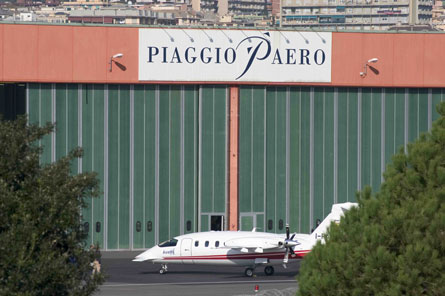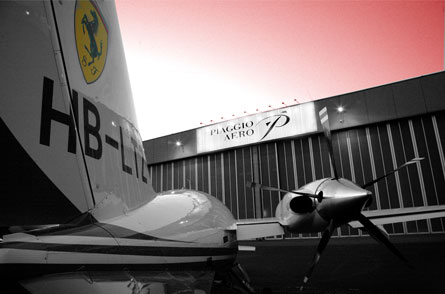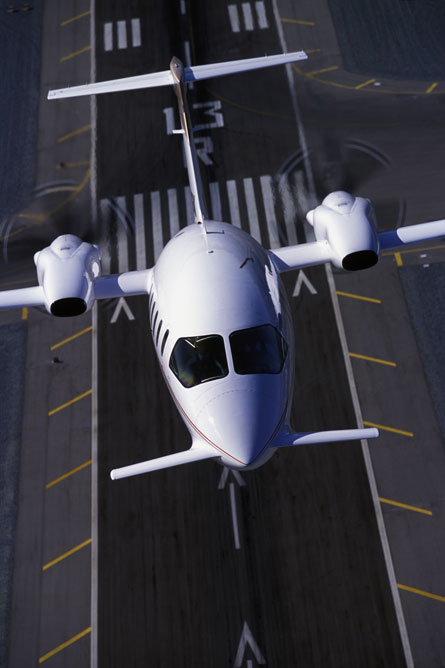A Piaggio P180 Avanti II - in a livery inspired by the night sky by artist Mimmo Paladino - was the star of shareholder Mubadala's stand at November's Dubai air show. Even without the striking one-off colour scheme, there is no denying the sleek Italian-designed canard twin-pusher is easy on the eye.
In the more than two decades since the delivery of the first Avanti, the Genoese airframer - part-owned by the head of the Ferrari family - has marketed the aircraft on its aesthetics as much as its flyability: a sports car of the skies which combines ramp presence, the cabin comfort and size of a mid-size jet and the fuel economy of a turboprop.
However, now a new market is opening up for the Avanti, and possibly a new jet Piaggio has been working on for several years. Although 18 of the 216 P180s currently in service are used in special mission roles, including as air ambulances, the company has tended to treat the sector as a niche. With the corporate and VIP market still sluggish - especially in the smaller cabin segments - Piaggio believes special mission variants will make up two fifths of its orders in two years.
 |
|---|
©Piaggio |
The reason for its optimism, explains chief executive Alberto Galassi, is a surge in interest from emerging markets such as Russia and a recent evolution in technology that makes the Avanti viable as a platform for airborne surveillance and analysis.
At Dubai, Flight Inspection Systems (FIS), the Russian organisation that inspects the navigation, radar and communication infrastructure throughout the CIS, signed a deal for five more Avantis to join its first P180, which has just entered service. The aircraft will be delivered from 2012.
The Avanti II received type approval for Russia only this year, but Piaggio is already negotiating with FIS for a potential order for up to 50 aircraft. If that and other possible business from Russia transpires, Piaggio may consider setting up an assembly line in the country. "This could be a business for us for 20 years," says Galassi.
What is remarkable is that Piaggio did not particularly target its latest customer. FIS had done its homework looking for an economical aircraft that could operate in extreme weather conditions, with short take-off capabilities to cope with primitive airstrips, and the room to carry the required on-board equipment, says Galassi: "They found us."
The other factor which has helped propel Piaggio into the special mission market is the same trend that makes smartphones tiny and lightweight compared with their counterparts a decade ago. Receivers, sensors, antennas, cooling systems and all the other equipment needed on a high-tech surveillance aircraft have shrunk.
"We have discovered that the P180 is not only a fantastic business plane," says Galassi, "it is a platform. In the past you would have needed an ATR or [Boeing] 737 to carry it all. Now you can do it with a smaller aircraft."
 |
|---|
©Piaggio |
Interestingly, given the P180's associations with Ferrari and its visual appeal, Galassi believes Piaggio's special mission customers are making their purchase decisions based solely on performance capabilities rather than less tangible brand values. "These are often government agencies that have to deal with a budget, so their choices are not just emotion," he says.
AEROSPACE AMBITIONS
Galassi believes Piaggio's new jet - which the company has been developing for years but has held back from releasing because of the state of the corporate market - will also win favour as a special mission platform. Piaggio has not formally announced risk-sharing partners for the "P1XX", despite reports it would do so this year, but a number of leading tier-one suppliers are known to be working with the company on a prototype. Mubadala's aerostructures subsidiary Strata is also a likely partner, with the Abu Dhabi fund suggesting several times that an assembly line for the jet is one of the emirate's aerospace ambitions.
Flight International has seen images of the project, which show a jet considerably larger than the Avanti in a special missions configuration. Galassi hints that in a continuing tough environment for business aircraft, the special missions market might end up being the primary one for the jet, as well as the Avanti.
He gives little clue as to a likely launch date. Piaggio's two largest co-shareholders, Mubadala and Indian conglomerate Tata, "don't like to make announcements. They like to deliver. So they won't be saying anything until the package is frozen".
Mubadala has owned one third of Piaggio since 2006, with Tata coming in as a one-third partner three years later. The injection of funds from two of the world's best-resourced investors was huge fillip for Piaggio, which had, until then, been treading water under former 100% owners, the Ferrari and Di Mase families, who had rescued the then-80-year-old manufacturer out of bankruptcy in 1998.
Other than the new aircraft projects, Piaggio has been renewing its infrastructure, with construction under way on a 50,000m2 (530,000ft2) subassembly, engine manufacturing and repair facility at Villanova D'Albenga, next to the airport in Liguria. It will open in 2013 and replace a 90-year-old plant in Finale Ligure. A long-running contract with Pratt & Whitney to supply parts for the PW200 helicopter engine and the F135 powerplant for the Lockheed Martin F-35, as well as other arrangements with Honeywell and Rolls-Royce, has provided a valuable income stream alongside aircraft sales.
 |
|---|
©Piaggio |
All-Avanti US fractional operator Avantair has been one of the bright spots on the corporate landscape for Piaggio. The Florida-based programme has a fleet of 57 Avantis and has a further 43 on order. While that deal has helped boost the P180's presence in North America, Galassi is aware its stateside prospects are likely to remain difficult. By contrast, Piaggio has been slow to break into emerging territories such as Latin America and the former Soviet Union.
"We have been weak in the strongest markets," he says. "We want to be strong in the strong markets." Piaggio's relationship with its newest customer should help it go some way to achieving that.
Source: Flight International






















